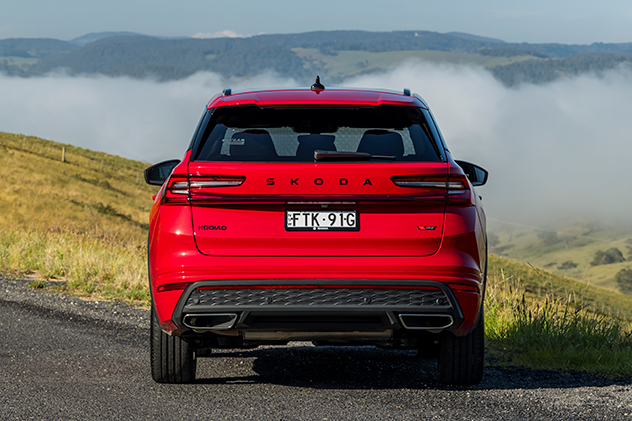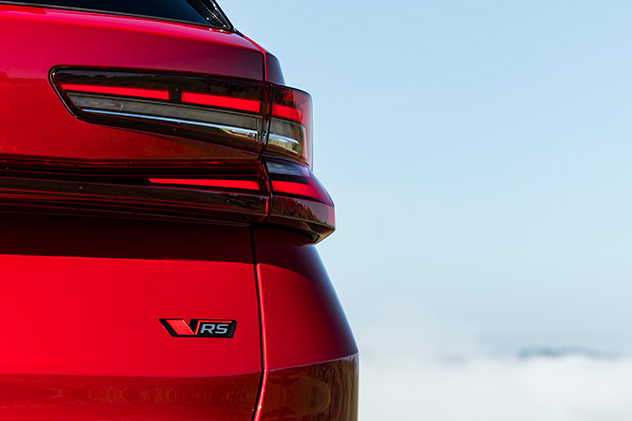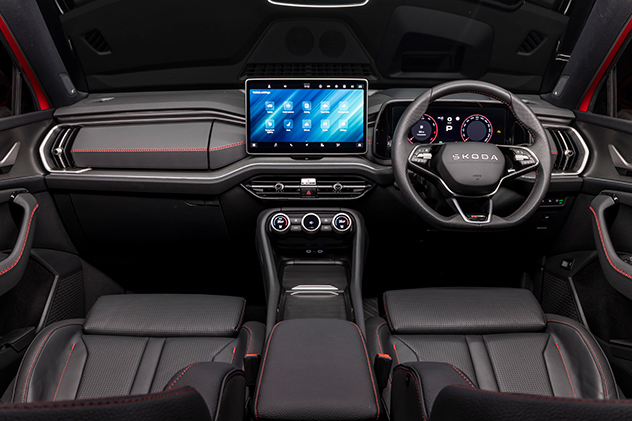
In new car parlance, the words ‘performance’ and ‘pragmatic’ don’t typically go hand-in-hand. On paper, however, the 2025 Skoda Kodiaq RS makes a compelling case. The second generation of Skoda’s sporty seven-seat SUV arrives in Australia this month bearing extensive changes inside and out.
Building on the wares of the regular Skoda Kodiaq launched locally in April this year, the second-generation RS is incrementally larger than its predecessor and offers a more mature design, plus additional technology and equipment.
A slight uptick in power and torque also helps extend the shelf life of the VW Group’s venerable EA888 2.0-litre turbo-petrol engine.
The sum of these changes is a more complete SUV – and a cheaper one, too.
The second-generation Skoda Kodiaq is priced at $69,990 plus on-road costs, which is $600 cheaper than the model it replaces. According to Skoda, that’s despite an additional $8000 in standard equipment.
In any case, the Kodiaq RS still commands a considerable premium over the regular entry-level Select, which starts at $54,990 plus on-road costs.
Rivals are pretty thin on the ground, too. There are flagship versions of the Kia Sorento (from $66,290 plus ORCs), the Volkswagen Tayron (from $73,490 plus ORCs) and the Hyundai Santa Fe (from $73,150 plus ORCs) – though you could argue none balances the performance-family juggle as well as the humble Skoda.
— Sam Charlwood






The RS moniker isn’t purely a marketing exercise. As well as a healthy uptick in power and performance, the badge applies a tasteful lashing of premium materials inside the cabin – plus an undeniable luxury bent.
The front bucket seats are torso hugging, yet supportive enough over longer journeys. They are set low inside the cabin to not only afford an excellent outward view but help cultivate maximum feeling and feedback between car and driver.
The steering wheel feels nice in the hands and soft-touch materials adorn the contact points. All these trinkets are worth mentioning out as they go some way in validating the premium price.
Then there are the Skoda-isms – an umbrella in the door, waste bins, centre touchscreen cleaner – not to mention the front-seat mounted phone holders for rear seat passengers and integrated second-row door shades. Incidental storage is strong up front, buoyed by recent revisions including the relocation of the gear selector to the steering column, which has liberated more space in its traditional console location.
Second-row space is likewise well considered, accessed via large door openings and replete with separate air vents, charging points and an open compartment that is perfect for holding odds and ends, plus drinks. The Kodiaq’s traditional SUV shape also means the second-row glasshouse isn’t compromised by a raked roofline, instead offering a broad outward view for adults and little ones alike. Second row leg room, head room, and shoulder room are likewise sound.
The third-row proposition isn’t as straight-forward. Access is narrow, owed to a simple tilt-and-slide function of the second row (with no option to tumble the seat forward to create a walkway).
Space is tight in the back row, even with the Kodiaq’s newfound exterior length – short trips for kids is the limit. Moreover, the third row isn’t serviced by dedicated air vents or top tether child seat points like the second row. That said, the curtain airbags do extend right to the rear of the car, which is a win.
Even though passenger proportions are limited, luggage proportions are not. The boot measures 794 litres – big enough to swallow three full-size suitcases or a designer pram – and is accessed via a generous opening (via electric tailgate access). The rear floor space is flat, complete with baggage hooks, a 12-volt outlet, luggage protection blind and nifty storage solutions.
Happily, the RS’s practical positioning is underlined by the fitment of a space-saver spare tyre.
As the flagship model in the Skoda Kodiaq line-up, the RS wants for very little with respect to equipment.
Standard gear includes 20-inch alloy wheels, Matrix LED headlights, LED tail lights, fog lights and daytime running lights, heated and ventilated front seats, heated steering wheel, heated outboard rear seats, auto-dimming and heated power side mirrors, leather appointed upholstery, black roof liner and A-pillars, automatic wipers and automatic lights. The list goes on.
Infotainment in the Kodiaq RS takes the form of a 13-inch centre touchscreen and a 10-inch digital instrument cluster in front of the driver. Apple CarPlay and Android are standard fare, as is digital radio, a wireless phone charger and four USB-C points dotted around the cabin.
Happily, the Kodiaq resists the minimalist trend, offering occupants a full complement of hardwired buttons, dials and switchgear. They are a cinch to navigate and save you needlessly scrolling through touchscreen menus.
Of particular note within the dashboard centre fascia are ‘smart dials’ that cleverly toggle between a choice of four features. The optional head-up is display clear and concise in its layout, helping streamline the driving process.
The Kodiaq is backed by a seven-year/unlimited kilometre warranty in Australia, and is covered under a guaranteed future value scheme.
Servicing intervals are set at every 12 months or 15,000km. A seven-year service pack will set buyers back $4400.
The Skoda Kodiaq carries a five-star ANCAP safety rating under the most stringent 2025 protocols, which is good news.
Even better, however, the surfeit of safety systems has been thoughtfully tuned so they don’t detract from the driving experience. In fact, you’d hardly notice they’re there – which is possibly the best compliment we could deliver.
Standard safety kit includes nine airbags, front assistance, turning assistance, crossroad assistance, adaptive cruise control, lane assistance, travel assistance, traffic sign recognition, rear-cross traffic alert, exit warning and driver attention monitoring.
Moreover, a reversing camera and front and rear parking sensors are standard.
There are no wholesale changes under the bonnet of the Skoda Kodiaq RS for 2025, but there are some improvements.
The Volkswagen Group’s enduring EA888 2.0-litre turbo-petrol four-cylinder engine has been massaged once more for 2025, pushing figures to 195kW/400Nm in this tune and lowering the official 0-100km/h sprint time to 6.3 seconds. For reference, its predecessor boasted 180kW/370Nm outputs, and a 6.6 second 0-100km/h time.
The Kodiaq RS makes use of the same seven-speed dual-clutch automatic gearbox and sends drive to all four wheels. Also as before, the RS requires premium unleaded fuel.
Elsewhere, the sporty flagship employs Skoda’s Dynamic Chassis Control (DCC), a two-valve adaptive suspension system which devotes one valve to compression damping and one to rebound damping – the upshot being better control and compliance and a more sophisticated ride.
Braked towing capacity is listed at 2.5 tonnes.
The spacious interior and clever tech are both agreeable features, but the most satisfying element of the second-generation Skoda Kodiaq RS is the way it drives.
The perky 2.0-litre turbo-petrol engine, sophisticated suspension and clever electronics combine to make a well-rounded driving experience – one with ample performance and, importantly, inherent comfort.
The two-valve adaptive suspension represents possibly the biggest improvement under the 2025 facelift. It feels more controlled over broken bitumen and does away with the ‘floatiness’ that occasionally beset its predecessor. Moreover, the suspension does an excellent job of keeping the Kodiaq’s circa two-tonne body in check during fast changes in direction, while the steering feels accurate and well-weighted across its different modes.
Riding on 20-inch wheels, the Kodiaq RS won’t be mistaken for a soft, pillowy SUV – some persistent road noise and a sportiness to the tuning of its controls put paid to that – but the end product remains civilised and polished in all driving scenarios. The real benefit comes through rugged backroads, where the Kodiaq RS uses its excellent body control and all-wheel drive underpinnings to deliver a sound and competent handling package.
Furthermore, the corresponding 2.0-litre turbo-petrol engine feels suitably sporty, revelling in the slight power and torque boost to offer a broader power curve overall and reducing the need to downshift as regularly under heavier squeezes of the accelerator. Granted, the engine and its seven-speed dual-clutch automatic gearbox are still prone to some hesitation at standstill (even inducing a shudder upon taking off on a solitary occasion on test), but the combination feels less elastic in its power delivery than earlier incarnations. Once up and moving, the gearbox is decisive with its inputs and offers an ample spread of ratios; at highway speeds the tachometer rests at a miserly 1500rpm.
After a circa 300km loop on mixed roads and speeds, we averaged 8.8L/100km – emerging from the cabin feeling fresh and suitably cosseted.
Many new vehicles claim to combine family-friendly qualities with sporting attributes, but few do it as well or as cheaply as the Skoda Kodiaq RS.
The second-generation Kodiaq RS improves the recipe in every measure. It’s fun, offers enjoyable on-road dynamics, and is inherently practical. Proof that performance and practical can coexist, especially in an SUV.